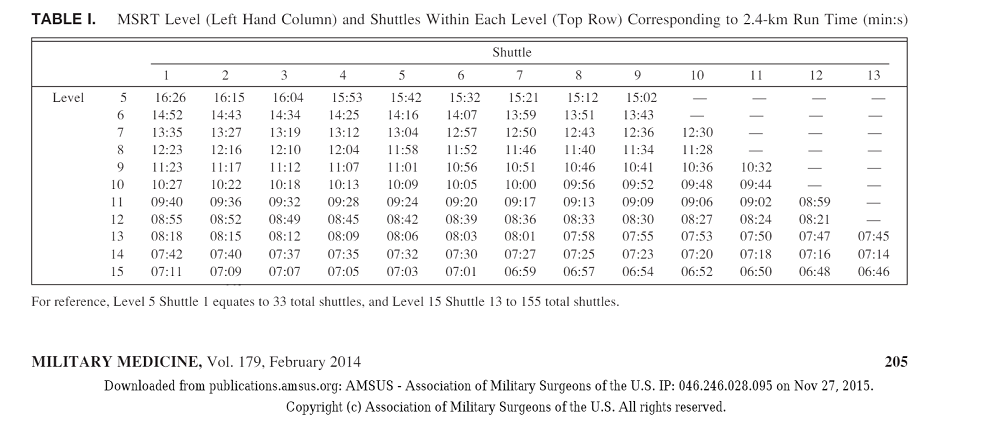|
When training for the Australian Defence Force, physical fitness and achieving your potential in the Physical Fitness Assessment will be at the forefront of your mind. The rigorous standards required to rise to the challenge put your mind into sharp focus, and you will want to perform at your very best. Most ADF applicants dread the beep test the most. Which is why we make sure our applicants' training regime prepare them appropriately, so they go into that assessment day with confidence in their fitness level and abilities. We make a point about running being just as important a component of your conditioning as Push-Ups and Sit-Ups. Our ADF applicants often ask us about how the 2.4km run relates to their beep test results and whether it's an efficient training method for improving their beep test score. In this article, I'll look at these two tests, how they're essential for ADF applicants and what the science says about their relationship. The Beep Test The beep test is a shuttle run assessment designed to measure your cardiovascular fitness and your endurance around a 20m flat course marked out by cones on either end, requiring a change of direction performed at speed. The runs are synchronised around audible beeps which speed up the longer the test continues. This means that you have to get faster as the assessment goes on, making it a challenging test of endurance which finishes at maximal effort sprints. You only get one attempt at this part of the PFA, so optimal performance at a maximal effort on the day will be essential. Just to recap the ADF requirements:
Training for the beep test should not be done with beep tests, though. It's a method of assessing VO2 max, not a way to improve it. At The Barracks Gym, we use three primary forms of training to prepare our members for their Physical Fitness Assessment adequately.
The test itself is physical - an endurance test that speeds up at the point when you are getting tired. It's also a test of maximal effort - by the final rounds, you will be stopped when you can no longer maintain the required sprint pace. But an often overlooked component is the psychological element. The test isn't over when you've met the minimum necessary standard, but when the assessor stops you. This means you need to train to push past your expectations and perform to your best ability. The 2.4km Run Many branches of the armed forces across the world use the 2.4km run as an aerobic fitness benchmark for their personnel, along with the multistage shuttle run. The aim is to run it in the shortest possible time. If we look at Royal Australian Air Force requirements, men need to be under 12 minutes, women under 13 minutes to be accepted for recruit training. For the Royal Australian Navy, the fitness requirements during the 2.4km run are 13 minutes for men and 15 minutes for women. If you think about it, there may be instances during your time in the ADF where you need to march or run for longer distances wearing your boots an carrying your equipment. Your body must be conditioned to cope in those circumstances. What Does the Data Say? Research published in the journal Military Medicine performed in the UK detailed the relationship between the 2.4km run (performed on surfaced roads) and the multistage shuttle run (performed in a gymnasium with a wooden floor). The conclusions of previous research had highlighted that both the 2.4km run and the beep test are good predictors of maximum oxygen uptake and can effectively estimate aerobic performance. It was essential to be able to confirm that interchangeable use of these tests, as they were being used that way by the British Military. The tests were performed as a correlation with a standard deviation to account for error for both male and female participants in an independent groups design. The researchers needed to know if they were making a fair comparison, or if they needed to use additional data - such as body mass - as a way to assess occupational fitness in aspiring military applicants. They found a very strong correlation between performance across both assessments (r=0.92), meaning that the 2.4km run and the beep test were very similar assessments of aerobic fitness and that they can be safely used interchangeably with one another. Check out the table below to see how they relate. Despite their differences in design, the two methods can be used interchangeably, and the 2.4km distance (1.5 miles) is a suggested training method to prepare for the beep test in the ADF. Using field-based running assessments is a practical and logistical way to assess aerobic capacity, endurance and cardiovascular fitness. Further, it's of practical advantage to maintain aerobic fitness when on active duty. When there are space limitations, safety concerns or environmental factors which make the 2.4km run assessment not possible, the beep test can reliably and validly be used in its place. ConclusionsThe beep test for the physical fitness assessment in the ADF, used alongside other measures of performance, is a test of occupational fitness to carry out active duties. It is very closely correlated with the 2.4km run in terms of aerobic capacity and cardiovascular fitness without the inclusion of any other data points.
For more support on how to prepare for the Physical Fitness Assessment day, including specific guidance on how to fuel yourself with the proper nutrition and even the appropriate footwear to give yourself every possible advantage - reach out and chat to one of our team and book in your 2 Week Trial.
2 Comments
1/6/2021 07:49:17 pm
Thanks for sharing with us! This is a good article.
Reply
Michael
1/9/2021 06:16:56 pm
Most welcome! Are there any other aspects of training you'd like us to do an article about?
Reply
Leave a Reply. |
Most PopularTrusted PartnerWe work with the best service provider for Defence and First Responders.

Get SocialCategoriesArchives
January 2024
|
© COPYRIGHT 2024. ALL RIGHTS RESERVED.



 RSS Feed
RSS Feed